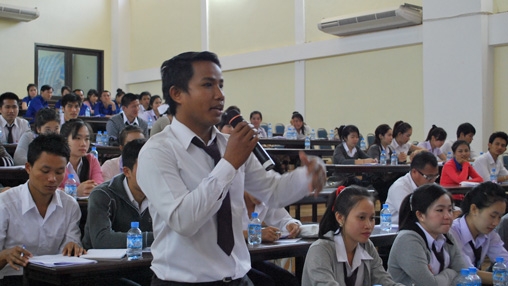Vientiane, April 5, 2012 – Over 400 teachers, students and provincial government officials took part when a World Bank road show presented and stimulated discussions on the topic of three of its analytical reports—the Lao Economic Monitor (LEM), Investment Climate Assessment (ICA), and Public Expenditure Review (PER) from February 20 to 28, 2012.
Lao experts working at the World Bank participated in discussions at the National University of Laos in Vientiane, Souphanouvong University in Luang Prabang, and Champasack University in Champasack province.
“By sharing the findings of the World Bank’s main economic reports on Lao PDR widely across the country, the World Bank aims to encourage active engagement of stakeholders – students, researchers and government officials - in the country’s development discourse", said Ms. Keiko Miwa, Country Manager of the World Bank to Lao PDR. “The World Bank is committed to sharing knowledge and information, and we want to stimulate discussions on the findings of these reports”, she added.
Lao Economic Monitor
The Lao Economic Monitor (LEM) is the World Bank’s comprehensive medium-term review of the country’s economy published twice per year in Lao and in English, the most recent report was launched in January 2012.
The report projects an estimated eight percent GDP growth in 2011 that is mainly driven by hydropower, manufacturing, and service sectors. Many students participating in the discussion raised concerns about the country’s high dependency on natural resources, and on the mining and hydropower industries, for its economic growth.
“Exploiting natural resources and minerals is not sustainable”, said Vice Dean Sihata Chankeovithoun of the Faculty of Economics and Business Management of Champasack University. “We should be looking at other sectors as well.”
Keomanivone Phimmahasay, World Bank Economist, said that Lao PDR indeed was facing a challenge in diversifying its industries. Effective natural resource management was needed for the sustainable economic growth of the country.
“Lao PDR needs to be selective in choosing quality investments when natural resources are involved. There is also a need to promote non-extractive sector investments such as tourism,” she said, “At the same time, good public financial management should be practiced to ensure that all, particularly rural and poor communities benefit equitably from the revenues of the extractive industries”.
“Improving the country’s human resources and skills base is key for creating a better future,” added World Bank Senior Economist Somneuk Davading.
Investment Climate Assessment
The Investment Climate Assessment (ICA) for Lao PDR was carried out by the World Bank in close coordination with government agencies and development partners. The report presents suggestions on how to address fundamental challenges impeding sustainable business growth and how to improve the investment climate.
The report mentions that business growth and competitiveness in Lao PDR is driven by skills development, easy access to finance, and an improved tax rate. The report has found that there is currently a mismatch between the skills possessed by the available labor force and the type of skills potential employers are looking for.
“Improving vocational education and adding more training initiatives will help improve the job shortages and skills mismatches,” said World Bank Trade Analyst Konesawang Nghardsaysone, “Public-private partnerships along with a longer-term plan to improve basic education could address this growth impeding problem”.
Upon learning from the Investment Climate Assessment report that the construction sector incurred most loans, Sithilikone Phengsavath, a teacher from Souphanouvong University, asked: “What policies can facilitate access to loans for other sectors?”
“Promoting fair competition in the banking sector could make finances more accessible to people and businesses across sectors. Establishing an efficient registration system for real estate and other movable collaterals, such as vehicles and machineries, is also crucial,” said Mr. Nghardsaysone, “More importantly, financial literacy of borrowers should also be improved”.
Public Expenditure Review
The Public Expenditure Review (PER), also a joint analytical work of the World Bank and related government agencies, examines public financial management systems in public services. The PER findings show that plans, budgets, and sector allocations should be based on the total resources available and sector objectives. Ensuring that there is a right balance between capital and recurrent spending in sectors is also crucial.
Students were very interested in issues relating to revenue allocation. “The health and education service providers should receive more budgets in order to effectively and efficiently provide those basic services to the people,” said Phetsamay, a National University of Laos economics student.
Public Sector Specialist Saysanith Vongviengkham explained: “The Government always gives high priority to the social sectors. The budget allocations for the education and health sectors have increased in recent years, especially in 2011-2012, despite being below the targets defined by the National Assembly.”

